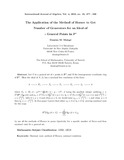| dc.contributor.author | Maingi, Damian M. | |
| dc.date.accessioned | 2013-05-07T10:51:43Z | |
| dc.date.available | 2013-05-07T10:51:43Z | |
| dc.date.issued | 2010 | |
| dc.identifier.citation | International Journal of Algebra, Vol. 4, 2010, no. 10, 477 - 500 | en |
| dc.identifier.uri | http://erepository.uonbi.ac.ke:8080/xmlui/handle/123456789/19763 | |
| dc.description.abstract | Let S be a general set of s points in P4, and R the homogeneous coordinate ring
of P4. Then the ideal of S, IS has a minimal free resolution of the form:
0 −−−→ F3 −−−→ F2 −−−→ F1 −−−→ F0 −−−→ IS −−−→ 0
where Fp = R(−d − p)ap−1
R(−d − p − 1)bp , d being the smallest integer satifying s ≤
h0(P4,OP4 (d)) and ap = h0(TS ⊗ Ωp+1
P4 (d+ p + 1)), bp = h1(TS ⊗ Ωp+1
P4 (d + p + 1)) and
d+3
4
<
s ≤
d+4
4
, with 0 ≤ p ≤ 3 and when p = 0, we would have ap−1 =
d+4
4
− s and when p = 3
then bp = s−
d+3
4
. In this paper I prove that either a0 = 0 or b0 = 0 by proving maximal rank
for the map:
H0
ΩP4(d + 1)
−→
s
i=1
ΩP4(d + 1)|Si
by use of the methods of Horace to prove bijectivity for a specific number of fibres and then
maximal rank for a general set. | en |
| dc.language.iso | en | en |
| dc.subject | Maximal rank, | en |
| dc.subject | method of Horace, | en |
| dc.subject | minimal resolution | en |
| dc.title | The Application of the Method of Horace to Get Number of Generators for an Ideal of s General Points in P4 | en |
| dc.type | Article | en |

